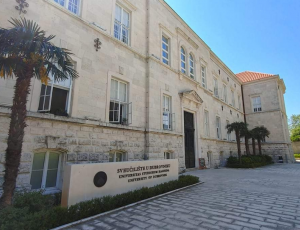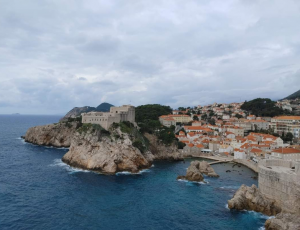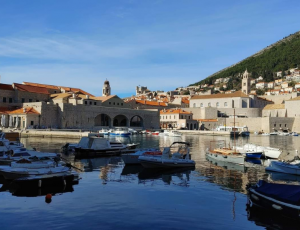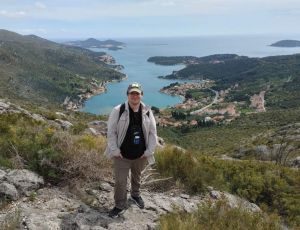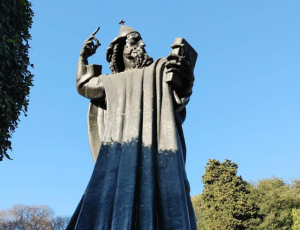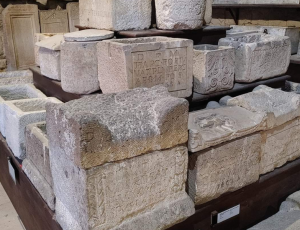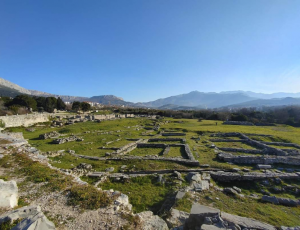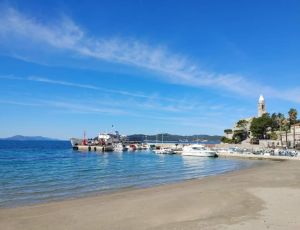by Nathaniel Whelan
When graduate student Dylan Corbett informed his supervisor that he wanted to research the coastal regions of Croatia for his Major Research Essay, Dr. James Casteel told him about a new opportunity with the University of Dubrovnik. Intrigued by the idea of going abroad, he quickly applied, and was later awarded funding through the Erasmus+ programme to support his travels.
Erasmus+ provides funding for research mobility between the European Union and their international partners. Through higher engagement between faculty members, our involvement with this prestigious programme has been steadily growing, with more institutions across Europe becoming interested in partnering with us. Since 2017, Carleton students, faculty, and staff have travelled to a number of countries, including Greece, Italy, Romania, Spain, and Türkiye.
Dylan graduated back in 2022 from St. Thomas University in Fredericton with a BA in International Relations and Political Science, and a minor in Italian. After an initial job search, he enrolled in the European, Russian, and Eurasian Studies (EURUS) MA program at Carleton to further develop his professional skills. He wasn’t in Ottawa for long, however, embarking on his 3-month research visit to Dubrovnik shortly after the beginning of the winter term.
For his Major Research Essay, Dylan is looking into how centuries of Latin and Italian occupation and hegemony within the coastal region of Dalmatia, Istria, and the Kvarner Gulf has shaped Croatian collective memory, as well as national identity and consciousness.
Before leaving, Dylan spent hours in the library, reading old travel logs and archeological reports from the region to gain as accurate of a representation of the ancient Roman, Venetian, and Italian fascist periods as possible. But, he admits, nothing compares to physically being in that place, experiencing the contents of those documents firsthand.
Interacting with the people, exploring the city and taking in its history gave Dylan a deeper understanding of how Croatian collective memory was formed and continues to evolve. Instrumental in guiding his research were the various museum exhibits and national monuments he visited during his stay.
“Each tells a story, of a person, of a place, of a time long past. By understanding these stories, we can begin to piece together the jigsaw puzzle that is a nation. They tell us where they came from and how the people and events of those times influenced the progression of what would become the country of today.”
One monument of particular interest to Dylan was the statue of Gregory of Nin in the city of Split. Gregory was a medieval bishop in the 10th century and staunch advocate for the continued use of the Slavonic and old Croatian Glagolitic languages that were banned in favour of Latin. When the Italians took over Dalmatia in 1941, they campaigned to destroy anything related to Croatian and Yugoslav nationalism, which included the removal of the statue of Gregory. It was only after the war that the statue was put back. Today, it is viewed as a symbol of Croatian resiliency.
Dylan has always been fascinated by history, but struggles to devote himself to one time period and location. By exploring collective memory in this way, he can study many different aspects of Croatia’s past, as well as the actors from other parts of the world who played a role in shaping their national identity.
In addition to his interest in history, one of the reasons Dylan joined EURUS was because of the timely events unfolding in Eastern Europe with the invasion of Ukraine. Part of his experience abroad included witnessing how this tense geopolitical situation is transcending borders. Dylan noted a high number of cars with Ukrainian license plates on the roads, refugees who drove all the way from their home country seeking safety.
On a night bus from the capital of Zagreb back to Dubrovnik, Dylan met a Ukrainian woman who shared her story of fleeing the war to live with her mother in Croatia. Her father, who fought on the front lines, had recently been killed in action. She learned fluent Croatian over a few months to assimilate quickly and now works full-time to support her mother.
“This experience was a powerful one for me, to see firsthand how the war is impacting Ukrainians who now find themselves trying to live and carve out a life outside Ukraine… It amazed me how stoic she was talking about it all.”
While in Croatia, Dylan made friends with people from many different countries, including Germany and Georgia, opening himself up to varying worldviews. With an ear for languages, Dylan managed to pick up a fair amount of Croatian as well just through his daily interactions. “If only I can stop myself from saying hvala (thank you) now that I’ve returned home,” he joked. “It really demonstrates to me how impactful travel can be when you take the time to become a part of the community around you.”
For his research, Dylan travelled up and down the coast of Croatia. On his downtime, he did a lot of hiking in the local mountains and even found time to go to Italy and Slovenia.
Dylan first caught the travel bug back in 2017 when he went to France with his high school for the 100th anniversary of the Battle of Vimy Ridge. In 2018, he went to Scotland and Ireland to investigate his family’s history. But this Erasmus+ experience was the first time he travelled solo, something he now encourages everyone to try at least once.
“If I have one piece of advice, it would be to travel by yourself somewhere you have never been. You learn to be independent and come away with skills and knowledge you could only have gained by working through things alone. It showed me just how capable I can be. This was truly a once in a lifetime experience I will never forget.”
In the future, Dylan hopes to revisit the Balkans, as well as travel to Japan, Korea, and Taiwan to expand his knowledge of the history and culture of those regions.
To learn more about available mobility opportunities to Europe, please visit our Erasmus+ webpage.
